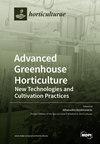Evaluation of Bioactive Functions and Quantitative Analysis of Phenolic Compounds of Glehnia littoralis from Different Regions
IF 3.1
3区 农林科学
Q1 HORTICULTURE
引用次数: 0
Abstract
Glehnia littoralis F. (GLF), a perennial herb indigenous to the coastal areas of northern Pacific countries is widely utilized in medicine for various diseases and symptoms. The current study aimed to determine the relationship between phytochemicals and their diverse functional abilities. High-performance liquid chromatography and a photodiode array detector were used to identify chlorogenic acid (1), rutin (2), isoquercitrin (3), psoralen (4), 8-methoxy psoralen (5), and bergapten (6). 2,2′-Azino-bis(3-ethylbenzothiazoline-6-sulfonic acid) (ABTS+)- and 2,2-diphenyl-1-picrylhydrazyl (DPPH)-radical-scavenging assays were conducted. It was found that GLF from the Chungnam Province had a higher content of compounds 4–6 contents of approximately 51.29 µmoL/g, which was primarily composed of bergapten (6) (44.44 µmoL/g). Moreover, GLF from Jeju Island exhibited the strongest ABTS+- and DPPH-radical-scavenging activities, with IC50 values of 6.69 mg/mL and 10.26 mg/mL, respectively, followed by Chungnam Province and Jeonnam Province. In contrast, the radical-scavenging activities of GLF did not correlate with compounds 4–6 (furanocoumarins) and were predicted to be related to compounds 1–3. These differences in chemical composition and biological functions are consistent with differences in environmental conditions. Therefore, GLF with high amounts of flavonoid compounds such as rutin and isoquercitrin could potentially be utilized as herbal medicines; however, further research into their additional biological effects is needed.不同地区滨海格氏藻的生物活性功能评估和酚类化合物定量分析
Glehnia littoralis F.(GLF)是一种原产于太平洋北部国家沿海地区的多年生草本植物,被广泛用于治疗各种疾病和症状。本研究旨在确定植物化学物质与其多种功能能力之间的关系。研究采用高效液相色谱法和光电二极管阵列检测器对绿原酸(1)、芦丁(2)、异槲皮素(3)、补骨脂素(4)、8-甲氧基补骨脂素(5)和佛手苷(6)进行了鉴定。进行了 2,2′-叠氮-双(3-乙基苯并噻唑啉-6-磺酸)(ABTS+)-和 2,2-二苯基-1-苦基肼(DPPH)-自由基清除试验。结果发现,忠南道的 GLF 中化合物 4-6 的含量较高,约为 51.29 µmoL/g,其中主要成分是莽草苷(6)(44.44 µmoL/g)。此外,济州岛的 GLF 表现出最强的 ABTS+-和 DPPH-自由基清除活性,IC50 值分别为 6.69 毫克/毫升和 10.26 毫克/毫升,其次是忠南道和全罗南道。相比之下,GLF 的自由基清除活性与化合物 4-6(呋喃香豆素)不相关,预计与化合物 1-3 有关。这些化学成分和生物功能的差异与环境条件的差异是一致的。因此,含有大量类黄酮化合物(如芦丁和异槲皮苷)的 GLF 有可能被用作草药,但还需要进一步研究它们的其他生物效应。
本文章由计算机程序翻译,如有差异,请以英文原文为准。
求助全文
约1分钟内获得全文
求助全文

 求助内容:
求助内容: 应助结果提醒方式:
应助结果提醒方式:


